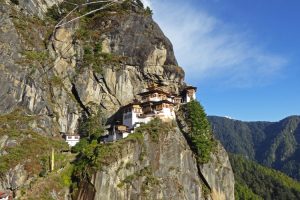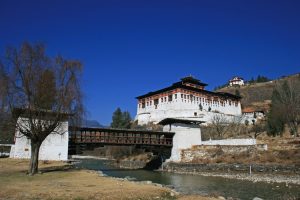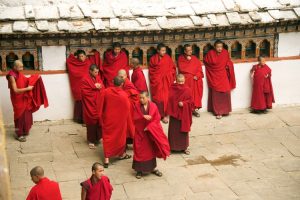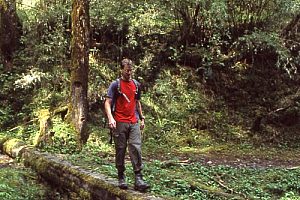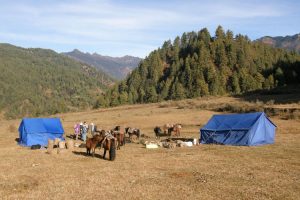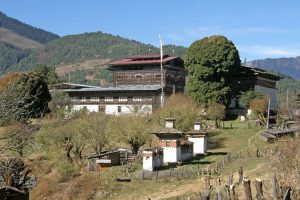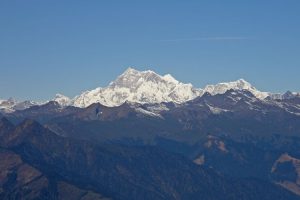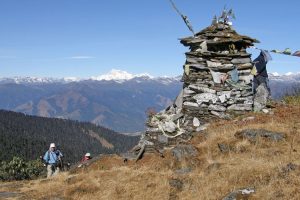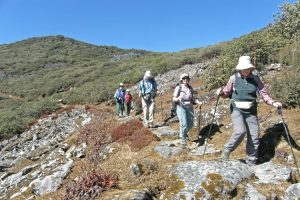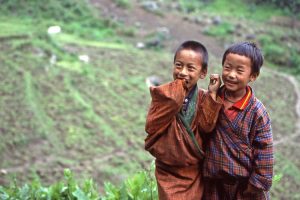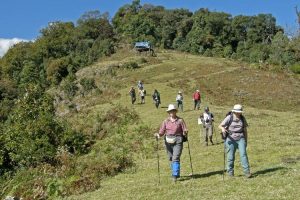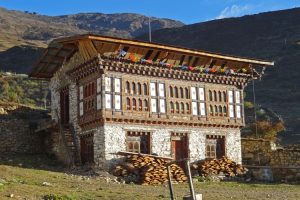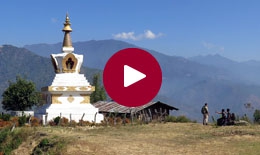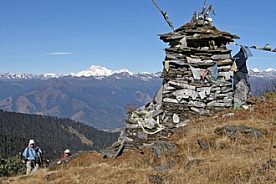
- Grade:
-
?
Vigorous / Strenuous
Vigorous: Suitable for enthusiastic hill/mountain walkers.
Strenuous: Suitable for fit individuals who have regular experience of mountain walking.
Find out more...
Vigorous / Strenuous
-
?
- Duration: 20 days from the UK
- On trek: 8 days Walks on: 4 days
- Private Departures Available
Flight inclusive from £6340, Land only from £5295
Trek from Bumthang in central Bhutan to the far east using the ancient ‘Red Rice’ route and crossing the famous Rodang La Pass.
Highlights
- Trek along an ancient trading route in a remote, beautiful and culturally fascinating area of eastern Bhutan
- Keep watch for yetis near the Rodang La - a traditional haunt of this most elusive of creatures
- See numerous varieties of colourful and exotic birds in one of the world’s birding hotspots
- Walk to Tiger’s Nest Monastery, the most spectacularly located in all Bhutan
- Visit many of the dzongs, temples and other key cultural attractions of eastern Bhutan
- Join the celebrations at a traditional Bhutanese festival
We are delighted to offer this exceptional trekking holiday into a region of Bhutan that sees few trekkers and remains largely untouched by tourism or the modern world. The trek traverses the scenic ‘Red Rice Route’, used in ancient times to transport rice from the fertile valleys of the east to the wealthy families of Bumthang. You will be travelling in the opposite direction though, starting from the religious and cultural heartland of Bumthang, trekking across the Rodang La, 4,109m/13,482ft, to reach Tashi Yangtse in the far east of the country.
In 2020 the Bhutanese government recognised the historic importance of this route and much of the trail has been upgraded.
The 8 day trek passes through varied landscapes from dense forests, to open meadows and from deep verdant valleys to high mountain passes where there are fabulous views of the surrounding countryside and high Himalaya beyond. The area is known as a birding hotspot and you will no doubt enjoy sightings of unusual and colourful birds which your expert local guide will help identify. Alongside the splendid flora and fauna there is much of historic and cultural interest to discover including temples, monasteries, chortens and even a nobleman’s palace. You will also trek through traditional villages revealing an authentic way of life and where you will find a warm welcome from the hospitable, local people only too happy to share a cup of their home-brewed ara!
Along with exotic birds and curious locals the other creature you may encounter en route is the mysterious yeti – known locally as the migoi. The area around the Rodang La is renowned in local folklore for sightings of this elusive beast so, as you trek in the footsteps of the red rice traders, listen out for a mysterious whistling on the pass, and if you do find strange footprints remember that the Bhutanese migoi are said to have the unique ability to walk backwards!
In addition to trekking along this ancient route you will walk up to Taktsang Monastery in Paro - the legendary Tiger’s Nest and visit Tashigang Dzong – one of the most strategically important in all the Thunder Dragon Kingdom.
The superb trek, together with the wealth of cultural, historic and natural attractions, make this a hugely rewarding and interesting trip for those looking to experience a different side of Bhutan.
Private Departures
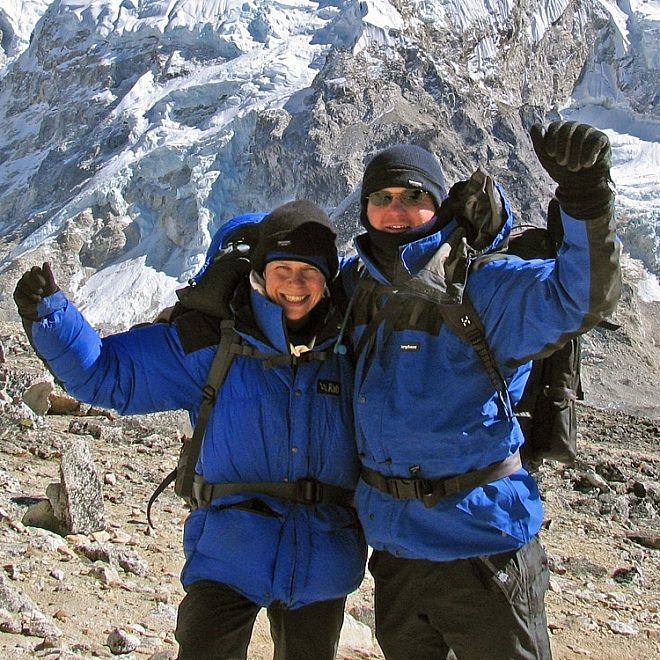
Rodang La Trek, Eastern Bhutan - Private Departures
If you would prefer to travel just with your partner, friends or family, we can arrange a private departure of this holiday. You follow the same itinerary, but travel on dates that suit you. Alternatively we can include elements of this holiday in a bespoke Tailor Made itinerary. Contact our friendly team for details and prices, and to make a booking.
At a glance
Vigorous / Strenuous
Duration: 20 days from the UK
On trek: 8 days Walks on: 4 days
Max. Altitude: 4,129m/13,545ft, Rodang La, Day 10
Private Departures Available
Guaranteed to run for a minimum of 4 clients
Maximum group size: 12
Accommodation types: Hotels, Camping
Festival:
Attends the Jakar Tsechu in 2023
Attends the Jambay Lakhang Drup in 2024
Meal arrangements: Bed and breakfast in Kathmandu and Delhi and all meals elsewhere, with 18 breakfasts, 16 lunches and 16 dinners.
Itinerary overview
| Day | Activity |
|---|---|
| 1-2 | Fly to Kathmandu. |
| 3-4 | Fly to Paro. Walk to Taktang Monastery and sightseeing in Paro Valley. |
| 5-6 | Fly to Bumthang. Walk to visit temples. Visit Chumey Valley and ridg walk. |
| 7 | Start trek. Walk to Ngang Lhakhang (Swan Temple). |
| 8-9 | Trek to Ugyen Choling and Phokpe. |
| 10 | Cross Rodang La and trek to Pimi. |
| 11 | Trek to Khaine Lhakhang. |
| 12 | Drive to Tangmachu and visit giant statue. Drive to Lhuentse and visit dzong. Visit Khoma village and drive to Minje. |
| 13-14 | Trek to Pemi and Taupang. Cross the Dong La Pass. |
| 15-16 | End trek and drive to Tashiyangtse. Visit Chorten Kora and Bumdeling Black Necked Crane Reserve. |
| 17 | Drive to Tashigang with visit to Goma Kora on the way. |
| 18 | Drive to Samdrup Jongkhar. |
| 19-20 | Cross into India. Drive to Gauhati. Fly Delhi. Fly to UK. |
Leader: Local leader, Bhutan
You will have an English speaking Bhutanese guide. Mountain Kingdoms have been working with the same partner in Bhutan since 1986. Their guides are some of the best in the Kingdom. They speak fluent English, as this is taught in all Bhutanese schools, and are fully qualified guides. The Tourism Authority of Bhutan insists that a Bhutanese trek or tour leader must pass his/her guiding exams in Thimphu before accompanying groups of foreign visitors. Guides receive regular ‘top-up’ training and 15 of our regular leaders have completed an extended training course run by Mountain Kingdoms in Bhutan.
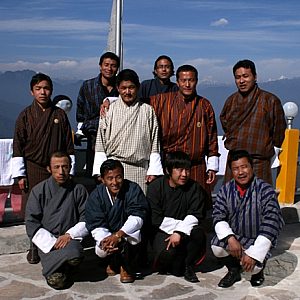
Holiday Itinerary
Day 1 - Depart UK.
Depart London on your overnight flight to Kathmandu.

Day 2 - Arrive in Kathmandu.
On arrival in Kathmandu you will be met at the airport and transferred to your hotel.

Day 3 - Fly to Paro, 2,250m/7,380ft - 1 hour flight. Sightseeing in Paro.
You will be transferred to Kathmandu airport to take the Druk Air flight through to Bhutan. The flight is only 40-50 minutes but taking off from Kathmandu you very soon see the Himalaya spread out on the left hand side of the plane, and if the weather is clear you may see Everest. Before the plane starts its descent into the Paro valley, you may see the second highest peak in Bhutan, Chomolhari.
On arrival you will be met by your Bhutanese guide and transferred to the Olathang Hotel which sits up on the hillside above Paro valley. The Paro Valley has had a great strategic importance in the history of Bhutan and was in the past an important staging post on the trade routes with Tibet. Paro Dzong, situated on a rocky outcrop above the Paro Chu and with views down both sides of the valley was historically one of Bhutan's strongest and most strategic fortresses. Before the rebuilding of the Tashidodzong in Thimphu it was also the seat of Bhutan's National Assembly. Depending on your flight schedule there may well be time to do some initial sightseeing in the Paro Valley and to have a look round Paro town.

Day 4 - Walk to Taktsang Monastery, 3,120 m/10,240ft. Sightseeing in Paro Valley.
In the morning you drive half an hour up the Paro Valley to where you start the walk to Taktsang, the most famous of all Bhutanese Temples. Taksang Monastery is commonly known as the 'Tiger's Nest' because it was said to be where the legendary Indian saint, Guru Padma Sambhava flew from Tibet on the back of a tiger to defeat five demons who were opposing the spread of Buddhism in Bhutan. Taktsang is perched some 600m/2,000ft up on a cliff overlooking the valley and although steep, the walk up is relatively straightforward, taking some 2-3 hours to ascend and a further hour or so to walk back down. You may have lunch at the café built at the main viewing point for Taktsang, or alternatively back at the Olathang Hotel.
In the afternoon you should have a bit of time for more sightseeing in the Paro Valley. You could visit the ancient temple of Kyichu Lakhang or walk up to the Paro Dzong, Paro's historic monastery/fortress. Sitting above the Dzong and housed in the old watchtower to the dzong is the national museum. The museum holds a fantastic collection of Bhutanese national treasures including the King's famous 'dragon hat', a wonderful collection of Bhutanese stamps, highly decorated thangkas (painted religious hangings), statues and weaponry. The museum was damaged in the earthquake of 2011, and while restoration is ongoing, some of its treasures will be displayed in a building nearby.
If you feel like a bit more walking you could walk back to your hotel from here.

Day 5 - Fly to Bumthang, 2,800m/9,186ft - 20-25 minutes. Bumthang Valley walk.
You will transfer to Paro airport for the domestic flight to Bumthang in central Bhutan. On arrival you will be met and transferred to your hotel.
The Bumthang region is considered to be the religious heartland of the Bhutanese nation and is home to some of its oldest Buddhist temples and monasteries. It is also a centre for culture and the arts, especially for weaving. Weaving is an integral part of Bhutanese society and traditionally every Bhutanese home is equipped with a loom for weaving with most young girls being proficient in the craft before they reach the age of twenty. Bumthang encompasses four major valleys. Jakar town where you will stay for two nights is in the main valley called Chokhor. The other valleys that make up Bumthang are the Ura Valley which is to the east, Tang valley, slightly more off the beaten track and the Chumey Valley located back towards the west.
Depending on flight timings you should have time this afternoon to explore the Bumthang valley from your hotel in Jakar town. You can make an almost entirely level walk taking in some of the principle sights of the valley. From the hotel you walk to Jambay Lhakhang, one of the country's oldest temples, built in the mid-7th century. One interesting feature to look for here is the set of three steps in the main temple. The first step, now hidden below floor level, is said to represent the time of the past or 'historical' Buddha. The second, very well worn, step represents the present Buddha, whilst the third step above, is said to represent the age of the future Buddha. The point at which the second step is worn down to ground level is held to be the time when the world as we currently know it will end.
From Jambay you take a farm track along the valley floor and walk for 30 minutes to reach Kurjey Lhakhang, a series of three large temples. The oldest of the temples here houses a rock indented with the body shape of Guru Rinpoche, whilst the most recent dates back just 25 years and was built by the Queen Mother - Ashi Kesang Wangchuck. Descending from the temples you cross a suspension bridge and walk downstream for 45 minutes to Tamshing Lhakhang, the most important Nyingma gompa in the Kingdom, established in 1501 by Pemalingpa, a famous Buddhist saint and teacher more popularly known as the 'Treasure Hunter'. Inside you can see a suit of chain-mail armour, which Buddhists believe will bring good fortune if put on and then while being worn, walked around the inner temple three times.
After your visit here your transport will meet you outside the gompa to return you to your hotel. You could stop to have a look at Jakar township on the way back and might also have time to visit the picturesque Jakar Dzong, the 'Castle of the White Bird', so called because a white bird was supposed to have indicated the most auspicious place to build.

Day 6 - Temples walk. Visit Chumey Valley and short ridge walk.
If you did not have time yesterday there will be the opportunity this morning to explore the temples in the valley near Jakar township.
Later you will visit the Chumey Valley and have a short warm up walk. You drive to Chumey and visit Nyimalung Monastery, founded in 1938, and home to over 100 monks. You can also visit Prakhar Monastery, a quaint village temple as well as Zugney, a famous centre for weaving. You then drive up to the cluster of temples at Tharpaling, a sacred spot and place of meditation, where several picturesque monasteries dot the hillside above the Chumey Valley with views over Domkhar (Chumey) and Domkhar Summer Palace. From here you walk along an old trail back down towards Chumey. The path starts out beneath craggy cliffs, from where it climbs fairly gently up to the ridge top to reach the Shutre Sae Pass at 3,700m/12,139ft where there is a glass case containing a statue of the founder of Tharpaling. From here the views are phenomenal - looking south you can see over the Chumey/Domkhar Valley with the Black Mountains in the distance. The other way you get fabulous and unexpected views over Jakar town with the airport runway and the dzong clearly seen far below. Beyond and further north, you can see towards the high mountains - on a clear day perhaps even as far as Mount Gangkar Punsum. You descend from the pass in beautiful forest, nearly all downhill. On the higher reaches, you pass through pine, fir and rhododendron forest. Eventually you reach the road again at a huge area of prayer flags where you meet your transport and drive back to your hotel in Jakar.

Day 7 - Trek to Ngang Lhakhang 'Swan Temple', 2,817m/9,242ft - 3 hours.
Today you will start your trek with the walk to Ngang Lhakhang, also known as Swan Lhakhang. First you drive the short distance to arrive at a long mani wall in Tangbi. You descend to cross the river by a suspension bridge and then have a pleasant walk of about 3 hours, up the river valley through forest and meadows to reach Ngang Lhakhang, also known as 'Swan Temple'. This temple has an illustrious history. Guru Rimpoche is said to have visited here and the present temple, built in the 15th century is said to be named after swans supposedly seen on a nearby lake by the temple's founder, a Tibetan lama named Namkha Samdrup.

Day 8 - Trek over Phephe la, 3,465m/11,368ft to camp below Ugyen Choling, 2,805m/9,200ft - 6 hours.
Listen out for barking-deer early this the morning. Your route today is largely through cool pine forest, climbing steadily through bamboo, fern and then Spanish-moss draped rhododendron, crossing small streams by stepping stones and crossing tree trunks. It is a 2½-3 hours walk to the pass, 3,465m/11,368ft, which is marked by prayer-flags - look out for Musk deer on the open hillside opposite as this is a favourite grazing spot for them.
Half an hour down from the pass you pass through a khonying (doorway) chorten and then descend through a series of summer grazing pastures used by villagers from Tendigang. There are two possible routes from here. One descends directly through the trees and will bring you to Ugyen Choling in 3-4 hours. The alternative route follows the high path across open hillside towards a small Lhakhang and village in the distance. There are lovely views down over the Tang valley, and the compact village of Tendigang is interesting to visit before continuing down a track to re-join the main trail.
The last section of today's trek takes you along the open valley bottom, through the attractive villages of Tahung and Kherab, before reaching camp set below Ogyen Choling Palace which overlooks the picturesque Tang valley.

Day 9 - Trek to Phokpe, 2,787m/12,425ft - 6-7 hours.
Ogyen Choling is famous for its important, ancient, nobleman's palace and after breakfast it is a 45 minute walk uphill to visit the palace. It is well worth taking a break here and looking round the museum. The known history of Ogyen Choling Palace dates back to the 14th Century and a visit from the great Tibetan master of Buddhism, Longchen Rabjam, who meditated in a cave above the village. The palace itself is believed to have been built in the 16th century, although all except a single building was destroyed in the 1897 earthquake. The current complex is a reconstruction of the original, rebuilt and extended at the turn of the 20th century. In the year 2000 the heirs of Ogyen Choling established a trust fund devoted to the preservation and maintenance of the palace as a religious and cultural centre. The palace museum is one of most interesting in Bhutan and offers a fascinating insight into the history of the Lama Chorjes (religious nobility) of Bhutan. It houses old photographs, a host of traditional household items as well as dance costumes and printing equipment. If you are lucky you might meet the owner of the palace, Kunzang Choden, who is the author of 'Tales of the Yeti'.
You leave Ogyen Choling, on the often muddy path through the centre of the village and climb gently through open meadows, with nice views back over the palace. After an hour the trail leads into the pine forest where you walk uphill on narrow paths with a dense canopy of bamboo over your head. Eventually the forest gives way to a series of dwarf-bamboo fringed meadows, and you traverse the ridge, while occasional views down the valley can be glimpsed through the trees. Look out here for Himalayan Monal, a member of the pheasant family - the male is a brilliant blue.
You will camp in the upper reaches of a large meadow. Across the ridge you can see the remote Phokpe Lhakhang. There is sometimes a herd of yaks in this meadow. A wooden hut was built at the campsite some years ago at the top of the meadow. the evening meal may be cooked here.

Day 10 - Cross the Rodang La, 4,129m/13,545ft, and trek to Pimi, 3,036m/9,960ft - 7-8 hours.
Today you will cross the Rodang La. The Rodang La has a significant place in Bhutanese folklore because of its importance in successfully navigating this vital trade route across Bhutan. There is a local saying which says of the steepness of the trail, that 'the Rodang La is fair in making us all equal. The master and the servants have to dismount from their horses and walk'.
Your trail leads out from the top corner of the meadow and climbs gently through tall pines and rhododendron, much of it covered in fabulous hanging Spanish moss. There may be fallen trees here, as this stretch of path is not often used. The large traditional knives (patang) which your trekking crew carry may come in handy to make the path passable for the horses. These woods are alive with birdlife - home to the distinctive Rufous-necked Hornbill, and Large-billed crows which like to follow travellers through the woods - especially when you stop for lunch! The trees finally give way to bush-rhododendron, and you climb on a rough stone stairway to the first pass, which is above the tree-line. A small stone chorten and prayer-flags mark the pass which is around 2-3 hours walk from Phokpe. There are good views of the eastern Himalaya, including Gangkar Punsum, in fine weather. The rocky path descends gently through meadow and rhododendron.
In this area be sure to look out for unusual footprints, not just for the elusive migoi (yeti) who has been traditionally sighted in meadows near the pass, but also for big cat pug marks, which were sighted on our reconnaissance trek. In 2018 we found an area with large animal faeces which were of a large predator. An hour on from the first pass a short climb brings you to a narrow gap in the rock face with steep cliffs on both sides and dramatic views. This is the start of a sensational descent.
Be careful on the descent, as the stone stairway, which descends steeply for several hours, is moss-covered in places and can be slippery. The path then finally levels out, bringing respite for tired legs, continuing along a tree-lined path until you arrive at Pimi, an open meadow with an old ruined guesthouse.

Day 11 - Trek to Khaine Lhakhang, 2,035m/6,675ft - 6 hours.
From Pemi you continue to descend steeply along a forgotten footpath through dense rhododendron forest, the huge leaves either crunching or squelching underfoot - depending on conditions! After a couple of hours you emerge into a small meadow which gives you your first views of Khaine Lhakhang along the valley and Ungaar village, still a long way below on the valley floor. There are simple stilted herder shelters in the meadows here. You continue your descent through slightly more open terrain until you finally arrive at the suspension bridge, 1,770m/5,806ft, over the Noyurgang Chu and cross to enter the delightful village of Ungaar. The descent to the bridge from Pimi is some 4,150ft and takes around 4 hours.
Leaving Ungaar you cross a second bridge where you will meet your vehicle and make the short drive to Khaine Lhakhang. You pass several small chortens and mani-walls on the outskirts of other settlements before arriving into the village. Khaine Lhakhang itself is beyond the first section of the village and commands pleasant views. Known as the 'sleeping-dog' temple, this simple lhakhang is believed to be one of the 108 geometric temples constructed by King Songtsen Gampo, 7th century founder of the Tibetan empire.
Ara Be very wary of local hospitality in this valley. The villagers are extremely hospitable and the traditional welcome for any visitors is a minimum of two large bowls of their home-brewed ara (a cloudy spirit distilled from rice, wheat or corn.) The local speciality is to serve the ara warm with shredded fried-egg in the bottom of the bowl. Traditionally you would be expected to drink a further two bowls on departure - something you may find challenging at eight in the morning - but which certainly sends you on your way with a spring in your step! As the people of this valley speak an entirely different dialect, any basic Dzongka you may have learnt will not help you to decline their copious ara refills.

Day 12 - Drive to Tangmachu and visit giant statue. Drive to Lhuentse and visit dzong. Visit Khoma weaving village. Drive to Minje, 1,985m/6,505ft.
After breakfast you will drive to Tangmachu. Nowadays the village of Tangmachu is famous for its huge copper statue of Guru Rimpoche, built on the ridge top to keep watch over the village and the surrounding countryside. There are great all round views from the ridge top and you may be able to see the terraced fields of Minje, on the opposite side of the valley, where you will be camping tonight.
The 173ft tall statue was built by the Druk Odiyana Foundation, a non-profit organisation founded by the Venerable Khengo Karpo Rinpoche in 2004. Its purpose is to bring peace and prosperity to the world and benefit all sentient beings. No doubt you will be surprised at how remote this is.
You then drive all the way down into the valley and turn left to continue to the town of Lhuentse. Lhuentse Dzong, situated above the town on a rocky hilltop known as Linglingthang, is quite impressive and is well worth a visit. It was damaged in the earthquake of 2011 but has been restored. The dzong was formerly the ancestral home of the kings of Bhutan, with its origins dating back to the seventeenth century when a monastery was founded on the site by Kunga Wangpo. Today it is the administrative and religious centre for the Lhuentse District. The township below the dzong is known as Gangzur and is a pleasant place to explore and to perhaps enjoy a cold soft drink or a beer after your time on trek.
Later you will drive up to visit Khoma village. Khoma is known throughout the country for its production of Kishuthara, an intricately patterned silk textile. The women of Khoma work in makeshift textile cottages, weaving the delicate designs and patterns. They will be happy to show you their elaborate weaving, and although you may buy textiles here there is no hard sell. Be warned that prices are not cheap, although the high prices reflect the immense amount of work and the value that the Bhutanese give to such fine weaving.
Finally you will drive the 1,000 metres up to Minje Village. There are two possible campsites in Minje - one on some terraced fields close to the village school, the other above the main village in an open meadow alongside the Darchu Pang Lhakhang. This area is renowned for its fragrant herbs, particularly lemon-grass - try crushing a small piece between your fingers to release the fragrance.

Day 13 - Trek to Pemi, 3,150m/10,335ft - 4-5 hours.
If you have camped near the school the previous night your day will probably start with the school bell and some very curious small faces peering down on your campsite. If your guide can obtain permission from the school's head teacher It is fascinating to witness the outdoor morning assembly.
From the school campsite it is a 20-minute climb to the lhakhang (also a possible campsite). This is a small and recently built lhakhang. The guardian will be happy to show you around the building and the small well-tended garden with its lovely geraniums. Leaving the lhakhang behind you climb steadily, on what can be muddy paths, through oak and rhododendron forest, until you reach an open meadow, Pawachen, at 3,100m/10,171ft, a meadow used by villages for summer grazing. The trail continues through virgin forest and light bamboo. Continue through a series of meadows containing flag-poles and summer cow-herder shelters until you reach your campsite at Pemi, 3,150m/10,335ft. Although there are campsites further along the trail, Pemi is the last site with sufficient water supplies for larger groups.

Day 14 - Cross the Dong La, 3,980m/13,056ft. Trek to Taupang, 2,508m/8,226ft - 8-9 hours.
This day is long and involves a descent of approximately 1,702m/4,500ft, but is quite an adventure! You continue steadily upward as the trail winds along the ridge, initially through more summer grazing pastures then plunging back into the trees - hemlock, spruce, cypress and rhododendron. From around 3,500m/11,483ft you follow a twisting spiral pathway strewn with mossy boulders beneath swathes of Spanish Moss. In places there are some steep drops to your right and on a clear day you should be rewarded with good views as you continue to climb.
After around three hours you reach an open ridge-top with some old scattered prayer-flags. Stretching below is a sloping grassy meadow - occasionally used as a campsite for very small groups. Be aware that you may encounter green leeches here. They are harmless and can generally be avoided through applying a good Deet-based insect repellent.
A series of prayer-flags along the ridge mark the nine rocky crests (sisters) of the Dong-La, the highest of which is around 4,000m/13,124ft and decorated with a number of tall flag-poles. Your trekking crew will most likely stop here to add their own prayer-flags. Your gradual descent takes you past the ruins of an old house, a group of prayer-flags which mark the border of Lhuntse and Yashe Districts and across an exciting wooden bridge before arriving at Taupang. The meadow here can have high grass which your crew will need to cut or flatten to make your camp for the night.

Day 15 - End trek at suspension bridge, 1,895m/6,216ft - 6-7 hours. Drive to Tashi Yangtse, 1,820m/5,546ft - 40 minutes drive.
You leave the campsite and cross another wooden bridge, passing back into dense jungle. The trail descends slowly across stepping-stones, log walk-ways and notched log-bridges. This section can be muddy and slippery - a good day to wear your gaiters! There is a wealth of flora and fauna in the forest - look out for Fire-tailed Sunbirds, Verditer Flycatchers and the Satyr Tragopan amongst the giant ferns and bamboo. After 2½-3 hours you emerge from the trees into the welcome hamlet of Shakshing, 2,385m/7,825ft. The first little farm you come to has an ingenious way of keeping wild animals out of its fields - it has a stuffed fake tiger on a covered wooden platform in full view of the fields below!! From the chorten here it is another couple of hours through forest and inhabited clearings to the end of the trail where, subject to jeep-track conditions, your transport will be waiting to drive you to Tashi Yangste. Just 15 minutes down the track you see the old Tashi Yangtse Dzong perched on a hilltop ahead, and as you cross the river below the dzong by a modern road bridge you will see over to your right a very lovely ancient traditional covered bridge. The town of Tashi Yangste occupies seemingly the only bits of level ground in endless mountainous forest-covered Himalayan foothills.
Your accommodation in Tashi Yangtse is in the only guesthouse in town, which was renovated in 2017 and is centrally located. The afternoon is yours to enjoy a shower, perhaps a beer or two and to relax after your trek.

Day 16 - Explore Tashi Yangste. Visit Chorten Kora and Black-necked crane reserve at Bumdeling.
Today you have a day to explore Tashi Yangste and its surroundings.The town of Tashi Yangste sprawls over an open valley with the modern dzong set on the hillside at the top of town above the archery ground. This dzong is used purely for administrative purposes and also houses the judiciary court.
A short walk through the town centre with its selection of stores, bars and pool halls takes you down to the huge Chorten Kora set by the river. This is a large, white stupa built in about 1740 and one of the great cultural attractions of eastern Bhutan. It is built in the same style as the great stupa at Boudhanath in Nepal, but it's not really very like Boudhanath. The reason is said to be that a lama who visited Boudhanath and wanted to build a copy in Bhutan made a model of the stupa by carving a radish with the outline, but the radish unfortunately shrank and distorted before he got it back home! It is believed that once Chorten Kora was finally built and blessed, the demon which had previously terrorised the Tashi Yangtse valley was subdued and banished. The area surrounding Tashi Yangtse still has close contacts with the neighbouring Indian state of Arunachal Pradesh, such that one day of Chorten Kora's Important festival in April is set aside exclusively for people making the pilgrimage here from Arunachal Pradesh. Above the town is the Arts and Crafts Institute of Zorig Chusum where training is given in various skills such as woodcarving and weaving. Here you may see the student craftsmen at work and perhaps buy some of their wares. There is also a very interesting wildlife centre/museum, and a deer enclosure.
Later you may visit the reserve for Black-necked cranes located at Bumdeling along the valley from Tashi Yangtse - the cranes normally migrate to Bhutan from Tibet between November and early March so they may have already started arriving. It is a very pleasant valley to walk in for a little way along.

Day 17 - Drive to Tashigang, 1,140m /3,739ft, with visit to Gom Kora en route - 4-4½ hours.
Today you drive down the valley to Tashigang. On the way you visit the charming little temple of Gom Kora, one of the quirkiest places in Bhutan! As well as viewing the pretty little temple which has some very lovely faded old frescoes inside, you may go around behind the temple to undertake a number of challenges - make a sacred circuit, attempt to climb a large rock up the 'stairway to paradise', drink the sacred water which flows down the rock or squeeze into a tiny holy cave where Guru Rimpoche is said to have subdued a demon in the shape of a ferocious serpent which came down the valley from Tibet. You may also test your sin by carrying a very large boulder three times round the central stone. If you find the rock heavy then you have a lot of sin!
You then drive further down the valley and will spot Tashigang's spectacular dzong ahead, set high above the valley, before you cross the river and climb up to the town itself. Tashigang is an attractive town, the largest in eastern Bhutan, with pretty painted houses, lots of bright bougainvillea and geraniums, and bustling shops and cafes. The centre of Tashigang is clustered round a small central plaza with a large prayer wheel, a bank, a few shops and bars but not much else. There is a small souvenir shop here which is not very inspiring! Below the plaza is the dzong, overlooking the valley. This dzong, one of the most strategically important in the country, was built in the 17th Century to guard against Tibetan invaders. The afternoon is yours to explore the town, do a spot of handicraft shopping or just to relax at one of the simple street-side cafes.

Day 18 - Drive to Samdrup Jongkhar - 181km, 6-7 hours.
Remember to keep your passport on you today as you may need to show it as you enter Samdrup Jongkhar.
First, leaving Tashigang, you pass through Sherubtse and the campus of the country's premier University College before you climb to the Yongphula Pass, 2,190m/7,185ft. About 2-3 hours from Tashigang you reach Khaling, where one of the most famous weaving centres in Bhutan is located, providing cloth for the royal family. If the centre is open you may stop for a short visit. It is a further 4-5 hours drive from here to Samdrup Jongkhar. There are wonderful views of forested hills and valleys rolling away to the foothills and the Indian plains of Assam State. You can often see Langur monkeys, kingfishers, eagles and other brightly coloured birds along the roadside. The Indian-like border town of Sandrup Jongkhar is literally at the very foot of the Bhutanese foothills and is quite subtropical.

Day 19 - Cross border into India and drive to Gauhati - 116km, 3 hours. Fly to Delhi - 2¼ hours.
After breakfast you will drive across the border into India and pick up your Indian transport to drive you to Gauhati. You will immediately be aware of the extreme contrast between these two Himalayan neighbours and will soon find yourself missing the peace and serenity of Bhutan! You drive across the flat plains of Assam through tea plantations, cross the mighty Brahmaputra River, and arrive at Gauhati, the largest city in this region. From Gauhati you fly to Delhi where you will be met and transferred to your hotel near the airport.

Day 20 - Fly Delhi to London.
After breakfast you will be transferred to the airport to fly home.
Map
Map Key
-
 Airport
Airport
-
 Point of interest
Point of interest
-
 Mountain Peak
Mountain Peak
-
 Day walk in this area
Day walk in this area
-
 Flights
Flights
-
 Internal Transfers
Internal Transfers
-
 Trek
Trek
Loading...
Hold your place
Not quite ready to book? Why not call us on +44 (0) 1453 844400 to hold a no obligation place while you make up your mind?
No Surcharge Guarantee
No surcharges will be applied to your holiday after you book. Prices on this website are updated regularly. The Flight Inclusive holiday price, or Land Only holiday price, will be confirmed to you at the time you make your booking. There will be no surcharges after your booking has been confirmed.
Flight inclusive holidays
The 'flight inclusive' holiday prices shown on this website are based upon our preferred airlines and the best priced economy class fares we are able to secure at the time of publication.
We will be able to advise on fares with alternative airlines, upgrades to Business Class, and the options for flights from regional UK airports, please contact us for more details.
Booking your holiday
-
Deposit
From £400.00
For the majority of our holidays, a deposit payment of £400.00 per person is required to secure your place(s), however a small number of holidays require a higher deposit - please refer to the holiday itinerary for more details. If the holiday departs within 60 days, a deposit of £1,000.00 per person is required.
Book now!
- Book your small group holiday securely online – click the ‘Book’ button next to your chosen departure or visit our How to Book page
- Complete and return a Booking Form available to download here.
- Call us on +44 (0)1453 844400 and one of our travel specialists will talk you through the booking process.
What’s included
- An English-speaking Bhutanese leader
- Bhutan visa
- Flights between Kathmandu and Paro, internal flight from Paro to Jakar, and airport transfers
- The flight from Gauhati to Delhi
- 4 star hotel in Kathmandu, bed & breakfast on twin-share basis
- In Bhutan, good standard hotel accommodation in main towns and best available hotels in outlying towns, on full board, twin-share basis.
- Economy class return air fares from the UK & UK Departure Tax (flight inclusive only)
- Single timed group transfers for international flights on arrival and departure
- Camp staff to carry out all camp work
- All camping facilities and meals on trek
- Delhi airport hotel, twin share on B&B basis.
- Sightseeing where specified
- Carbon offsetting with the Ecoan Tree Planting Project (for clients taking our flight inclusive option)
What’s not included
- Travel insurance
- Visa fees for Nepal and India
- Lunch and evening meals in Kathmandu and Delhi
- Optional trips
- Tips
Read holiday reviews by Mountain Kingdoms travellers.
Overall score: 5 (Based on 5 reviews)
The way the trekking staff worked as a team and were really helpful and friendly--and adaptable! All in all a great holiday--would thoroughly recommend
Beautiful trekking and a warm welcome everywhere we went.
So lovely to be remote and quiet.
The Tsechu festival was superb, and as ever the Bhutanese people were a delight.
What an amazing insight into Bhutanese culture. The east of Bhutan is like another world.
Extend your holiday
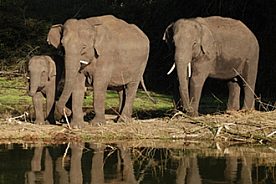
- Jungle activities including an elephant experience, bird watching, rafting and nature walks
- See wild elephant, rhinoceros, leopard, deer, wild boar and if you are lucky, the famous Royal Bengal Tiger
- Stay at the delightful Tiger Tops Karnali Lodge situated on the edge of the park
After your adventurous time in the Himalaya why not add a relaxing Jungle Safari to your trip? The Royal Bardia National Park is situated in the west of Nepal. We use Tiger Tops Karnali Lodge, which is acknowledged to be the best lodge in the area. Bardia’s remote geographic location and the fact that the lodge has only 12 rooms, lends a degree of exclusivity to the experience, in comparison to other more popular parks. From the lodge you will be able to participate in safaris and have the chance of seeing some of the country’s wonderful wildlife, for instance, wild elephant, rhinoceros, leopard, deer, wild boar and if you are lucky, the famous Royal Bengal Tiger. There is also the possibility of visiting the villages of the Tharu tribal people that surround the lodge. With its abundant wildlife, relaxing lodge and first class service, our Bardia extension is an experience you will savour!
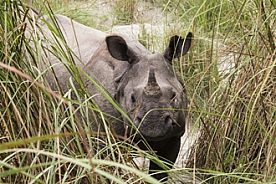
- Activities include; bird watching, elephant washing, canoe ride, elephant experience, landrover safari and jungle walks
- Choice of accommodation from budget to luxury
- Suitable to add to any holiday flying in/out of Kathmandu
Why not extend your adventure in Nepal by visiting Nepal’s jungle region for a complete contrast to the high mountains and the Kathmandu Valley. Chitwan is home to a rich and varied wildlife. Here are found wild elephant, rhinos, leopard, sambar, chital (spotted) deer, wild boar and arguably the most magnificent of cats, the Royal Bengal Tiger. You may even see sloth bear, gaur (wild cattle) and crocodiles. Chitwan is also wonderful for birdlife especially in the spring, when the jungle rings day and night to the calls of several kinds of Asian cuckoo.

- Escape the crowds and hustle and bustle of Kathmandu
- Walks available from the cottage - explore the nearby countryside
- Single and double rooms available, or exclusive hire of the entire cottage
- Breakfast and dinner included, plus unlimited tea and coffee
While in Kathmandu, why not experience an exclusive, private, home away from home? Shivapuri Heights Cottage is a “home-stay-style” property that offers a great escape from the hustle and bustle of the City. It is located in 2 acres of land at an altitude of 6,000ft /1,830m on the edge of the protected Shivapuri Reserve, with beautiful views looking down into the Kathmandu Valley.
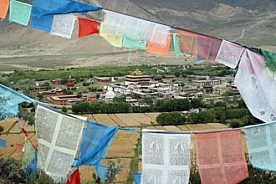
- Visit some of Tibet's most important historical and cultural sites and monasteries of Tibetan Buddhism.
- Offers a scenery completely different to that of Bhutan and Nepal.
- Suitable to add to any holiday flying in/out of Kathmandu.
A visit to Tibet offers an exciting extension to a visit to Nepal or Bhutan. Regular flights to Lhasa from Kathmandu make it possible to visit most of the major sights in and around Lhasa on an 8 day itinerary and a visit to Tibet will provide an exhilarating contrast to your trek or tour in Nepal or Bhutan. Tibet’s high plateau offers totally different and starker scenery to that of the other Himalayan countries. Here you will see some of the most important historical and cultural sites and monasteries of Tibetan Buddhism – the Potala Palace and Samye, Ganden and Drepung Monasteries.
If taking this extension you will need to spend an extra day beforehand in Kathmandu while our agents there process your Tibet visa. They will need your passport for the day for this purpose. You need to let us know in good time if you wish to take this extension as we need to put this process in hand and send your details to the Chinese Embassy in Kathmandu well before your departure date.
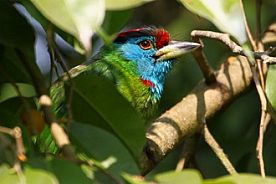
- Koshi Tappu is home to over 500 species of birds
- Look out for exciting wildlife like jungle cats, crocodiles and rare water buffalo
- Explore the park by foot, raft and jeep
- Stay in the pleasantly located Koshi Camp
Koshi Tappu Wildlife Reserve is one of the finest birdwatching and wildlife areas in all Asia. Located in south-east Nepal, the reserve covers 175 square kilometres with large expanses of open water created by the Koshi barrage, with marshes, lagoons, sandbanks and mudflats offering an outstanding wetland habitat. The reserve is home to over 500 species of birds, with the resident inhabitants being joined by large numbers of migratory species from Siberia and Tibet, which take up residence from November to February. The Koshi Tappu Wildlife Reserve provides one of the best places in Nepal to view migratory water fowl, waders and shore birds with many species seen here which are not recorded elsewhere in the region.
There is also much wildlife to be seen in Koshi Tappu including blue bull, golden jackal, Bengal fox, fishing cat, jungle cat, mongoose, civet cat, porcupine, Indian flying foxes and rare Gangetic dolphins as well as rare Marsh Mugger crocodiles. In addition, Koshi Tappu is the last habitat of the endangered Arna, a type of wild water buffalo.
During your visit you will explore the park with bird and animal spotting from a raft trip on the Koshi River, birdwatching walks, jungle walks and jeep trips. You will also have the opportunity to visit a family in one of the very interesting nearby local villages for a taste of rural Nepalese life. The Koshi Camp offers simple but comfortable accommodation and an expert staff of naturalists and birdwatchers to give you a comprehensive introduction to this wonderful area.
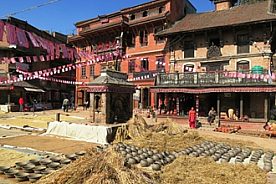
- Observe traditional crafts such as pottery, woodcarving and thangka painting
- Choose from a selection of full and half day guided tours
- Travel in a private car with a driver and an English-speaking guide
The Kathmandu Valley has a long and rich history and a vibrant culture and there is much that is worthwhile to see there - crowded bazaars, ancient temples, Buddhist stupas, crumbling shrines and picturesque palaces. The Malla kings who ruled in the valley created three major cities in the valley, Kathmandu, Bhaktapur and Patan and each of these cities has buildings that are showpieces for the art and architecture of local Newari craftsmen. We offer a selection of half day trips and full day trips to these sites the valley.
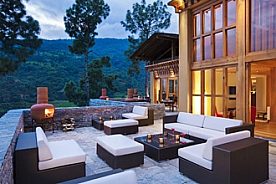
- Upgrade your accommodation for your trip in Bhutan.
- Choose from boutique and spa hotels in various destinations.
- Stay in luxurious properties with first rate service and facilities
- Enjoy fine dining and indulgent rooms
For our brochure trips to Bhutan we offer good standard tourist hotels and lodges, however, Bhutan also offers some lovely boutique and spa hotels which we are pleased to offer as upgrades on your trip. We offer a range of properties in Paro, Thimphu, Punakha and other towns all of which provide excellent facilities and service as well as attractive locations.
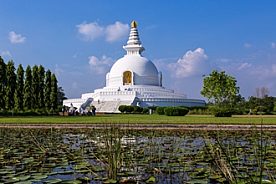
- Visit one of Nepal's most sacred Buddhist pilgrimage sites
- Stay in a comfortable hotel next to Lumbini
- Spend a full day touring the site with an expert local guide
- Flights and transfers to/from Kathmandu included
Enjoy a three day extension to the birthplace of Buddha, one of the most important Buddhist pilgrimage sites in the world. Take the short flight from Kathmandu, and spend two nights in a comfortable 3* hotel, just steps from the Lumbini temple complex, with a full day to explore the fascinating UNESCO World Heritage Site in the company of an expert local guide.
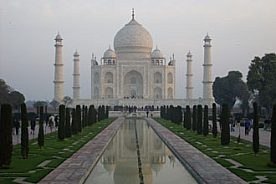
- 1-day and 6-day extension options available
- Add at the beginning or end of your holiday in India
- Sights include the Red Fort, Taj Mahal, City Palace and Amber Fort
After your adventures in India why not add an exciting day trip to Agra to see the sights of the one time capital of the great Mughal empire? Or, if you have more time available, perhaps a longer trip visiting both Agra and another gem of the ‘Golden Triangle’, Jaipur. Whichever option you take, once in Agra you will be looked after by one of our fully trained, English-speaking guides who will show you around the Red Fort, the Taj Mahal and the ancient city and mosque of Fatehpur Sikri. For those travelling on to Jaipur, you will take guided visits to the Amber Fort, Palace of the Winds and City Palace, along with time to explore the colourful bazaars of the ‘Pink City’.
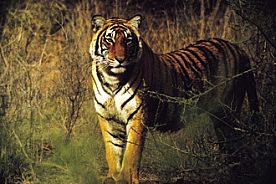
- Known for its population of tigers.
- Home to fascinating wildlife including jungle cats, hyenas, jackals, bears, crocodiles and large populations of langur monkeys.
- Enjoy safari drives as you look out for wildlife amongst the picturesque grassland, hills and lakes.
Ranthambore National Park in Rajasthan is one of the finest national parks in northern India. Formerly a hunting reserve for the Maharajas of Jaipur, you can see a huge variety of fantastic wildlife and birds in Ranthambore, but the park is particularly famous for its population of tigers - although of course sightings of tiger can never be guaranteed many visitors to this park are lucky enough to get good views. The scenery of the park is very varied with grassland, hills and lakes and there are also some very picturesque and atmospheric ruins located in the park. Even if you don’t see tigers there is abundant wildlife on view in Ranthambore with leopard and other cats such as jungle cats, caracal, hyena, jackal, wild boar, bear, several species of deer, and large populations of langur monkeys. Marsh crocodiles and other reptiles are also found in the lakes within the park. Owing to the wide range of habitats within the park there is also a large variety of fantastic and colourful birds, both resident and migrant, to be seen - in total, 272 bird species have been documented within the park.



